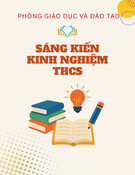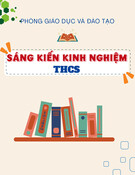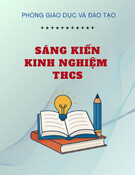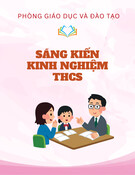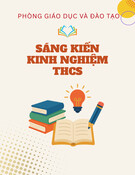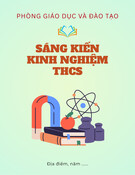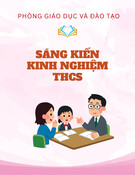NGHE AN DEPARTMENT OF EDUCATION AND TRAINING
------------o0o---------
INITIATIVE
USING INDUCTIVE APPROACH TO TEACH SOME GRAMMATICAL ITEMS THROUGH SHORT STORIES
Subject: English
School year: 2022-2023
NGHE AN DEPARTMENT OF EDUCATION AND TRAINING
PHAN DANG LUU HIGH SCHOOL
------------o0o---------
INITIATIVE
USING INDUCTIVE APPROACH TO TEACH SOME GRAMMATICAL ITEMS THROUGH SHORT STORIES
Subject: English
Full name: Phan Thi Thuong
Phone number: 0382576426
Full name: Trần Quốc Hải
Phone number: 0979075885
Group: Foreign Language
School year: 2022-2023
PART I: INTRODUCTION
Abstract
During this globalized world, English has been the tool language widely spoken in any formal or informal occasions to deliver and convey messages. The young generations nowadays are urged to actively enhance their English language proficiency in line with the transformation of the 21st Learning Century. In schools, teachers give much importance to vocabulary, grammar, pronunciation and try to cover their portions for the examination. However, the success of the academic activities relies mostly on the inspiration exerted from teachers, consequently leading to a significant extent of learning motivation in learners. This paper will focus on the benefits of using stories in teaching some grammatical items as an inductive method to make the lessons more enjoyable and gradually engage students into a communicative approach during a lesson of grammar.
The author also finds out that this direction provides more chances for students to learn English vocabulary in an effective way. More importantly, this method can be widely applied as inductive approach in teaching grammar in general. This is an incentive for my further findings in the topic of my initiative.
I. 1. Rationale Of the many issues related to language learning and teaching, grammar seems to get much attention from linguists and language teachers. The arguments of having an effective method to teach grammar have gone through a long history. Undeniably, grammar structures are very important in teaching and learning a language because they are the backbone of a language. However, how to teach grammar effectively is absolutely a challenge and it is also of constant concern among upper secondary school teachers.
To solve this problem, the author has come up with the idea to create short stories to introduce the grammatical points through the certain contexts or situations. It can be affirmed that learning through stories also makes the lessons more enjoyable to young students; therefore; a rise in the level of concentration during class could be easily observed. Stories are for all of us, especially for young children. In order to assure the feasibility of this approach, the author conducted a survey inquiring for the responses of the English teachers towards it.
The survey is for the teachers at my school and some others from different institutions.
1
Items Feasible Infeasible
Very feasible Less Feasible
It is essential that English teachers shift from deductive approach to inductive one in teaching grammar.
38.2% 61.8% 0% 0%
32.4 % 64.7% 2.9% 0%
Using stories as a good way to teach grammar is applicable in terms of inductive method.
50.0% 41.2% 8.8% 0%
Reading authentic stories helps improve English
44.1% 50.0% 5.9% 0%
Teaching grammar through short stories significantly stimulates English learners
36.3% 52.9% 11.8% 0%
Reading stories are helpful in pronunciation
47.1% 50.0% 2.9% 0%
Reading stories boosts learner’s lexical resource
It can be seen from the table that the majority of the responses fall in the “feasible” and “very feasible” categories. This accordingly affirms the potential effects of the research. In contrast, there is a very small number of participants leaning towards “less feasible” and no choices belong to “infeasible”. In addition to the contribution to an enjoyable grammar lesson, the initiative can further improve students’ pronunciation as well as lexical resources.
Those are the reasons why I choose the topic “Using inductive approach to teach some grammatical items through short stories”. I believe that stories are crucial not only in our mother tongue but also in foreign languages. Stories are a suitable introduction to English language as they present language in a familiar and communicative context. It is obvious that grammatical structures are explicitly constructed in the stories. Based on the organization of the story text, the author might draw the target points of grammar to transfer to the students through inductive approach.
I.2. Aims of the study
The aims of the study are as the follows:
2
- to help students gain the grammatical points through contextual situations in a short story. It means learning grammar in real situations.
- To develop students’ ability to apply grammatical knowledge in their communication better.
- To build up a fun atmosphere of learning English among learners.
-To shift the teaching method from “deductive reasoning” to “inductive reasoning”.
- By the end of the lessons, the students will be able to successfully form the sentences using the structures previously taught.
I.3. Scope of the study
The study was going to be conducted at my school for every student. Due to the limited time, I concentrate my work on students in class 10A6 and 10C1 who are non-major students in two normal classes of medium level but they are also interested in learning English. Most of the teachers at my school hope to use this method as a supplementary teaching aid and to renovate their ways of delivering any grammar lessons. Thus, there should be a plan to use short stories properly within English periods. Personally, I have planned to carry out my initiative from January to April of this school year 2022– 2023.
I.4. Research methods
Reading the materials related to the topic like Monkey Stories Software or the book “Storyfun” by Karen Saxby (Cambridge University Press) really encourages me in designing a grammar period through short stories. Moreover, I made some reference to the study about new methodology in teaching languages. I found out many changes made in order to give the young learners as many interesting lessons as possible.
Carrying out the teaching procedure in classes of grade 10, I would like to show the effects of my research seen through the theoretical principles and practical lessons.
I.5. Significance of the study
The study is conducted with a view to making some changes in the teaching method on grammatical items. I hope that my study would be a contribution to the new trend of education- that is how to make an interesting lesson and how to engage students more in their learning process. In other words, this would form a good way of teaching in general. The method used in the grammar lessons match with PPP teaching procedure or the ESA model.
+ “PPP” means Presentation, Practice and Production
+ ESA means Engage, Study, and Activate
3
The PPP Approach or the "Three Ps" approach to Language Teaching is the most common modern methodology employed by professional schools around the world. It is a strong feature of the renowned CELTA certification and other TEFL qualifications offered especially in the United Kingdom.
PART II : MAIN CONTENT
II.1 Theoretical background
II.1.1 Literature review on English grammar
II.1.1.1 What is grammar?
Grammar and vocabulary are components that should be mastered in teaching learning process of language. The word of grammar has several meanings and many definitions have been offered to explain about grammar. In the Oxford Advanced Learner’s Dictionary of Current English, grammar is referred to as “study or science of rules for the words into sentences (syntax), and the forms of words (morphology)”. The Longman Dictionary of Contemporary English defines grammar as “the study of use of the rules by which words change their forms and are combined into sentences.” Different experts also explain or define the term grammar differently. Harmer (2001:12) considers grammar as the description of the way in which words can change their forms and can be combined into sentences in the language. It is also defined by (Lado, 1977: 141) as the study of rules that are claimed to tell the students what should and should not say in order to speak language of the social educated class. In fact, grammar is “multi-dimensional” (Batstone, 1994) and has multi-meanings. Every language has grammar. It has been believed that if a language is a building, the words are bricks and the grammar is the architect’s plan. One may have a million bricks, but do not make a building without a plan. Similarly, if a person knows a million English words, but he does not know how to put them together, then he cannot speak English (Brumfit, 2000). In conclusion, grammar is the study of the classes of words, their inflections, functions and relations in the sentence of language.
Learning grammar means the study of how words are constructed in sentence well, when the pattern of grammar is used appropriately, and how the sentences will be interpreted correctly. It is assumed that it is not only how language is put together and how it works but it also tells about the system and patterns in selecting and combining words. More importantly, it shows the construction of sentences.
II.1.1.2 The importance of grammar
According to the definition of grammar, it is apparent why grammar is useful and important. Without mastering the grammar of a language, the students cannot comprehend the essence of the text and when they read. In this case, a good
4
grammar acquisition will help them in it. Grasping grammar knowledge helps students to understand every word when they are reading as well as speaking. “Imagine two car drivers. The first driver knows only driving and nothing about the working of the engine. He feels helpless whenever there is some trouble with machinery. The second driver knows driving and also understands the working principles. The person who knows grammar is like this second driver. In case he is doubtful about the correctness of a particular thing, his knowledge of grammar comes to rescue him (Kohli, 116)”. Therefore, to speak in a clearer and more effective manner we need to cultivate grammar in combination with lexical knowledge. For those who have unconscious knowledge of grammar, it may be sufficient for simple language use. But the persons who wish to communicate in the artistic manner with well-defined structures must go for the greater depth of understanding and proficiency that the study of grammar offer.
II.1.1.3 Principles of grammar teaching
Looking at what principles can guide us in the teaching of grammar; both Hedge and Thornbury (2001) give us some worthy answers. Hedge (2000) considered that the presentation of grammar to learners should facilitate learning in many ways. It can provide input for noticing output and accurate forms of English; it can present high-frequency of grammatical items explicitly to speed up learning; it can provide information about the communicative use of language structures by contextualizing them in written and spoken forms; it can give information implicitly through exposure to examples or explicitly through instruction on the stylistic variation of language form. Below are some rules of thumb about teaching grammar by Thornbury (2001).
●The Rule of Context
Teach grammar in context. If you have to take an item out of context in order to draw attention to it, ensure that it is re-contextualized as soon as possible. Similarly, teach grammatical forms in association with their meanings. The choice of one grammatical form over another is always determined by the meaning the speaker or writer wishes to convey.
●The Rule of Use
Teach grammar in order to facilitate the learners’ comprehension and production of real language, rather than as an end in itself. Always provide opportunities for learners to put the grammar to some communicative use.
●The Rule of Economy
To fulfill the rule of use, be economical. This means economizing on presentation time in order to provide maximum practice time. With grammar, a little can go a long way.
●The Rule of Relevance
5
Teach only the grammar that students have problems with. This means, start off by finding out what they already know. And don’t assume that the grammar of English is a wholly different system from the learner’s mother tongue.
●The Rule of Nurture
Teaching does not necessarily cause learning – not in any direct way. Instead of teaching grammar, therefore, try to provide the right conditions for grammar learning.
●The Rule of Appropriacy
Interpret all the above rules according to the level, needs, interests, expectations and learning styles of the students. This may means giving a lot of prominence to grammar, or it may mean never actually teaching grammar at all – in any up-front way. But either way, it is your responsibility as a teacher to know your grammar inside out.
II.1.1.4 Common techniques for Presenting Grammar
There is a variety of techniques for presenting new grammar items. Below is an overview of some most commonly-used. Note that no one technique will necessarily prove better than another, so the general rule when it comes to presenting grammatical rules is to combine a variety of techniques.
▪ Direct Explaining
You can explain a grammar rule directly using the students’ mother tongue. This has the advantage of allowing students to contrast an item of grammar in English with an item of grammar in the students’ own language. For example, the two languages might use past tenses in different ways. On the other hand, some teachers believe that it’s more effective to present and explain the grammar directly by using English at all times. Certainly, in classes where the students already have learnt some English, it’s usually possible to build on what they already know to introduce a new grammar point.
▪ Discovering the grammar
Often, it’s helpful to have students discover the grammar rather than telling them what it is. Do this by choosing a text which contains lots of examples of the target grammar. For example, if the text includes regular verbs in the past simple form (e.g. lived, travelled, moved, etc), ask the students to underline all the verbs in the text. Then ask them to say what they notice about the verbs – which will be that they all end in -ed.
▪ Drawing timelines (teaching tenses)
Timelines are useful for teaching grammar structures that refer to aspects of time. Timelines are a simple and visual way to clarify the actions and events described
6
in a sentence. They are often used by teachers for presenting the meaning of verb tenses in English.
The basic form of a timeline shows a horizontal line with a point in the middle indicating NOW or the moment of speaking. Before that point is the past and after it is the future. Some teachers also write the words PAST and FUTURE along the line. You can indicate single actions with an X and periods of time with an arrow. Continuous actions are often indicated with a wavy line.
▪ Using objects
Sometimes using objects can work as quickly as anything to present the meaning. For example, if you want to present the comparative form (… is bigger than …), the simplest way is to find two objects and contrast them. Alternatively, ask two students to stand up and compare their height to produce a sentence like: Hany is taller than Tom. Write the sentence on the board and underline the comparative form so the students notice the construction. Similarly, if you teach prepositions (in, on, next to, etc), using a selection of objects in different positions from each other is a very effective starting point.
▪ Contrasting structures
With higher-level grammar, it’s useful to ask students to contrast two grammar structures which are similar in certain ways, but which have an important difference in meaning. For example, these two sentences contrast two different meanings of the present perfect tense.
+ He has been to London.
+ He has gone to London.
A teacher could ask the students to compare these sentences and say what the difference in meaning is.
▪ Choosing the correct answer
This is similar to the previous technique because you give students two sentences, but one sentence has a mistake related to grammar. You write them on the board and get students to say which they think has the mistake and why. For example:
+ I’ve lived here since three years.
+ I’ve lived here for three years.
Students discuss the sentences in pairs. Sentence A. is wrong because we use “since” to refer to a fixed point in time (e.g. March, 1989, etc.) whereas we use “for” to describe duration of time.
II.1.2 Inductive and Deductive approach
II.1.2.1 Inductive
7
Inductive is used to describe reasoning that involves using specific observations, such as observed patterns, to make a general conclusion. This method is sometimes called induction. Induction starts with a set of premises, based mainly on experience or experimental evidence. It uses those premises to generalize a conclusion
Inductive reasoning is the act of using specific scenarios and making generalized conclusions from them. Also referred to as “cause-and-effect reasoning,” inductive reasoning can be thought of as a “bottom up” approach. For example, you might observe that your older sister is tidy, your friend’s older sister is tidy and your mom’s older sister is tidy. Inductive reasoning would say that therefore, all older sisters are tidy
Inductive reasoning starts with a single inference or observation drawn from specific and comparable situations. Unfortunately, getting an accurate inference or fair judgment might not lead to diversity. Inductive reasoning starts with something specific and then tries to generalize, which may be inaccurate. The logic can be sound, but further observation can prove it wrong
II.1.2.2 Deductive
Deductive is used to describe reasoning that involves arguments whereby, if the premises are true, then the conclusions must also be true. In a deductive argument, the conclusions flow directly from the premises given (Walton, 1989, p. 110)
Deductive reasoning is the act of making a generalized statement and backing it up with specific scenarios or information. It can be thought of as a “top down” approach to drawing conclusions. For example, consider the statement “all apples are fruits”. When you introduce specific piece of information like “all fruits grow on trees”, you can then deduce that all apples grow on trees.
Deductive reasoning can be misleading. The premises of an argument could be inaccurate, meaning the conclusion will be inaccurate too. This approach can also be time-consuming. Coming up with a valid argument and testing all the possible implications of the premises can take a lot of time, resulting in inflexibility and rigidity. People who depend on this method of reasoning can become unwilling to consider other points of view.
II.1.2.3 The Differences between Deductive and Inductive Approach
A deductive and an inductive approach basically differentiate into lesson procedures, learner roles, teacher roles and usage of metalanguage in the teaching process. A deductive approach is based on the top-down theory which the presentation and explanation of grammar rules take the precedence over teaching.
The language is taught from the whole to parts so learners understand the grammar rules and structures firstly. Next, they see the examples provided by the teacher
8
and finally, they begin to produce their own examples. In contrast to this, an inductive teaching is based on the bottom-up theory which accepts the view that language learners tend to focus on parts rather than the whole. For this reason, the teaching process begins with a text, audio or visual in a context. Secondly, learners work on the material to find the rules themselves. In the final stage, they give their own examples.
One another significant difference is the role of the teacher. In a deductive teaching teacher is the authority in the classroom. The main role of the teacher is to present the new grammar item to the learners. The second role is to prepare exercises for the students. The teacher is the organizer and controller of the classroom. Conversely in an inductive teaching teacher behaves as a guide and helper while students study the grammar rules themselves. It appears that while deductive approach is teacher-centered and traditional, inductive approach is student-centered.
A deductive approach makes language too descriptive by using language terminology. This leads to the perception that a language is only a tool for making descriptions. That is to say, while grammar is learned consciously in deductive approach, it is learned subconsciously in inductive approach. Therefore, it seems that an inductive approach is more natural and parallel to the language acquisition
Comparison Chart
Category Deductive Inductive
reasoning,
Introduction (from Wikipedia)
Inductive reasoning, also called induction or bottom-up logic, constructs or evaluates general propositions that are derived from specific examples.
logically a
Deductive also called deductive logic, is the process of reasoning from one or more general statements regarding what is known to reach certain conclusion.
Arguments Arguments in deductive logic are either valid or invalid. Invalid arguments are always unsound. Valid arguments are sound only if the premises they are based upon are true.
Arguments inductive in reasoning are either strong or weak. Weak arguments are always Strong uncogent. arguments are cogent only if the premises they are based upon are true.
Validity of conclusions
Conclusions can be proven to be valid if the premises are known to be true. Conclusions may be incorrect even if the argument is strong and the premises are true
9
II.1.2.4 The advantages of inductive approach
(1) Learners are trained to be familiar with the rule discovery; this could enhance
learning autonomy and self-reliance.
(2) Learners' greater degree of cognitive depth is "exploited."
(3) The learners are more active in the learning process, rather than being simply passive recipients. In this activity, they will be motivated.
(4) The approach involves learners' pattern-recognition and problem-solving
abilities, in which particular learners are interested in this challenge.
(5) If the problem-solving is done collaboratively, learners get an opportunity for
extra language practice.
II.1.3 Literature review on short stories
II.1.3.1 What is a short story?
Short story, brief fictional prose narrative that is shorter than a novel and that usually deals with only a few characters (https://www.britannica.com)
A short story is a fully developed story that is shorter than a novel and longer than a fable. It typically takes just a single sitting for reading. Short stories focus on the incidents bigger or smaller and evokes strong feelings from its readers. A short story often has a few characters in the plot (https://literarydevices.net)
The short story is usually concerned with a single effect conveyed in only one or a few significant episodes or scenes. The form encourages economy of setting, concise narrative, and the omission of a complex plot; character is disclosed in action and dramatic encounter but is seldom fully developed. Despite its relatively limited scope, though, a short story is often judged by its ability to provide a “complete” or satisfying treatment of its characters and subject.
II.1.3.2 Five important Elements of a Short Story
▪ Character
A character is a person, or sometimes even an animal, who takes part in the action of a short story or other literary work.
▪ Setting
The setting of a short story is the time and place in which it happens. Authors often use descriptions of landscape, scenery, buildings, seasons or weather to provide a strong sense of setting.
▪ Plot
A plot is a series of events and character actions that relate to the central conflict.
10
▪ Conflict
The conflict is a struggle between two people or things in a short story. The main character is usually on one side of the central conflict. On the other side, the main character may struggle against another important character, against the forces of nature, against society, or even against something inside himself or herself (feelings, emotions, illness)
▪ Theme
The theme is the central idea or belief in a short story.
II.1.3.3 What are the benefits of teaching grammar through stories?
“Stories are useful in language learning for young learners. The activities you do in class should help this kind of acquisition. Stories are the most valuable resource you have. They offer children a world of supported meaning that they can relate to. Later on you can use stories to help children practice listening, speaking, reading and writing.” (Slattery & Willis, 2001).
Everyone loves a story. Stories can be used for both eliciting and illustrating grammar points. A well-told story is the perfect context for a structure-discourse match, but the techniques can also be used effectively for a structure-social factor match. Storytelling is one of these extremely versatile techniques, and once you get familiar with it, it can be a convenient and natural grammar teaching tool. You may even find that it is the technique that holds students’ attention best, as well as the one they enjoy most. Grammar points can be contextualized in stories that are absorbing and just plain fun if they are selected with the interest of the class in mind, are told with a high degree of energy, and involve the students. Students can help create stories and impersonate characters in them. Students will certainly appreciate and respond to teachers’ efforts to include them in the storytelling process. But they will also enjoy learning through the stories. Stories should last from one to five minutes, and the more exaggerated and bizarre they are, the more likely students will remember the teaching points they illustrate.
Storytelling can be effective for teaching English to young learners for the following reasons.
● The purpose of telling a story is genuinely communicative.
● Storytelling is linguistically honest (It is oral language, meant to be heard).
● Storytelling is real (people do it all the time)
● Storytelling appeals to the individual while forging a community in the classroom.
Although some teachers are better at telling stories than others, almost any of us can tell stories with energy and interest. Students naturally like to listen to stories, and they are remembered long after the lesson is over. 11
II.1.3.4. Short Stories as Contexts in Teaching Grammar
Pardede (2011) pointed out different ways in which stories help students to learn grammar: First, stories enhance the memory through the identification of patterns, the stimulation of the imagination and any well-written short story is enjoyed by the readers. Stories can be used for both eliciting and illustrating grammar points. In addition, a well-told story is the perfect context for a structure-discourse match, but the technique can also be used effectively for a structure-social factor match. Thornbury (1999) rightly asserts that if the students are able to make sense of grammar, they first need to be exposed to it in its contexts of use. Brumfit and Carter (1986) have suggested varieties of ways in which the study of literature and language can be integrated and have also experimented with the implications of the use of literature in the language classroom. Their point is that literary text is almost the only context where different varieties of language can be mixed (Khatun, 2013). Students will certainly appreciate and respond to the efforts of including them in the storytelling process, but they will also enjoy learning grammar through stories. Nunan (1998) writes that in textbooks, grammar is very often presented out of context. Learners are given isolated sentences, which they are expected to internalize through exercises, involving repetition, manipulation, and grammatical transformation. These exercises are designed to provide learners with formal, declarative mastery, but unless they provide opportunities for learners to explore grammatical structures in context, they make the task of developing procedural skill- being able to use the language for communication- more difficult than it needs to be, because learners are denied the opportunity of seeing the systematic relationships that exist between form, meaning, and use. Collie and Slater (1991) suggests that amongst various genres of literature that can be employed for the purpose of teaching language, short story receives considerable attention for its length and inner construction. Due to its shortness a short story is feasible enough to be wholly covered in a class (Shaha, 2014). In this connection, Wajnryb (1990) asserted that accuracy in language acquisition plays an important role to understand both speaking and writing performances. Context gives a more precise understanding of how to use the grammar, and provides accuracy in the studied language both in oral and written skills
II.2. Practical background
II.2.1 Subjective factors
So far teaching grammar in English has been considered unchanged and inflexible because of traditionally consistent teaching methods. There seems to be very little adaptation for the grammar lessons; therefore; it causes the boredom among students. From my observation, most of the grammar lessons have been taught in a traditional way. For example, vocabulary is listed without context and grammatical structures are most commonly taught through worksheets, drills and rote memorization. "Thinking outside of the box and trying to teach these critical 12
skills through a project can be extremely challenging for some teachers (Fluent, 2016)". Moreover, both teachers and students at my school still face a number of difficulties and challenges in implementing the new teaching program in which the new things should be discovered and should be experienced.
Personally I think the main reason for this is that teachers still do not know how to apply the new technology in teaching job. They are so much familiar with the old teaching techniques that they find it a struggle to uncover themselves out of it. Besides that, students also partly contribute to this drawback. In 90% of my lessons, I have noted that my students want to listen to my explanation in Vietnamese. They expect to be provided the sounds or the grammar structures right away regardless of what I am trying to make it different. The most difficult part in a grammar lesson is when I expect them to use what they have learned into communicative activities in Production stage. It has been estimated that up to 80% of the students cannot do well in this stage.
II.2.2 Objective factors
It is a fact that the low level of students partly hinders the changes into communicative lessons among English teacher. Although they desire to plan a lesson in form of that way, there is a few obstacles from learners such as lack of motivation or reluctance to cooperate from students.
Another contributor is that teachers have not much taken advantage of technological devices in teaching foreign languages. In fact, the use of IT in teaching makes the lessons more interesting and draws more attention from students. However, at my school the innovation put in designing a procedure has not been sufficiently updated. Only the observation classes have been technologically invested. Sometimes, if there is a technical failure during teaching procedure, they feel discouraged. There is a shortage of the important ICT tools and applications used in the field of English Language Teaching as below:
+ Computers: This is the most important tool of information and communication technology and backbone of modern human life.
+ Overhead projector: It is an important tool of displaying information and processes to a large number of people simultaneously
+ Internet: It is the most important facility of communication. All the modern communication takes place through this.
Additionally, IT training courses for teachers are not taken into consideration by educational administrators. Meanwhile, the old generation of teachers needs to be regularly equipped with advanced technology to meet the requirements of modern teaching methods.
II.3 The target grammatical points applied
II.3.1 Used to 13
Step 1: Introducing the story “The Shady Past of a Butterfly”
14
15
16
Step 2: Presenting the structure “used to” through the story
(a) Teacher asks students to pick out the sentences using “used to” in the story.
17
For example: “I used to be a caterpillar”, “I used to eat sweet, young, green leaves”, “He used to come running after me to catch me”, ………
(b) Teacher asks students to observe these statements thoroughly and draw a principle of forming them.
(c) Students give their responses and teacher continue to explain further as follows:
18
19
Step 3: Practice based on the story Teacher designs the exercise based on the story to help students to be more familiar with the topic, changing it into a practice task. In addition, this adaptation apparently boosts a great deal of enjoyment in learning English, consequently teacher can easily engage the students into the lessons, motivating them to acquire new knowledge. After the students have finished the exercise, the teacher provides the key and give feedback to drill the structure “used to”. 20
Step 4: Production
- Teacher requires students to retell the story in their own words using “used
to”
- Teacher provides some language input if necessary
II.3.2 Be used to & Get used to
Step 1: Continuing the story “The Shady Past of a Butterfly”
21
22
Step 2: Presenting the structure “be used to” through the story
(a) Teacher asks students to pick out the sentences using “used to” in the story.
For example: “I am used to people loving me”, “My friend and I are used to getting lots of compliments”, …
(b) Teacher asks students to observe these statements thoroughly and draw a principle of forming them. (c) Students give their responses and teacher continue to explain further as follows:
23
Step 3: Practice based on the story Give the correct forms of the verbs in brackets 1. Madame Butterfly used to (eat) …………………...green leaves. 2. Madame Butterfly used to (look) ………………….. different from now. 3. The gardener is used to (see)………………………in the flowers. 4. They get used to (drink)………………… the nectar of flowers. 5. We got used to (eat) …………………….. leaves and flowers. 6. Madame has got used to (get)………………a lot of compliments. Key: 1. eat 2. look 3. seeing 4. drinking 5. eating 6. getting Teacher provides the key and give more feedback to students
Step 4: Production
- Teacher requires students to retell the story in their own words using “used
to” and “be/get used to”
- Teacher provides some language input if necessary
II.3.3 The passive
Step 1: Introducing the story “The paintings of Edvard Munch’s Scream and Art Heist ”
24
25
Step 2: Presenting the passive voice through the stories
(a) Teacher asks students to pick out the sentences in the passive voice in the story.
For example: “Two masterpieces were stolen”, “Another version was stolen”, “The scream has been stolen”, ………
(b) Teacher asks students to observe these statements thoroughly and draw a principle of forming them. c) Students give their responses and teacher continue to explain further as follows:
26
27
Step 3: Practice based on the story Teacher designs the exercise based on the story to help students to be more familiar with the topic, changing it into a practice task. In addition, this adaptation apparently boosts a great deal of enjoyment in learning English, consequently teacher can easily engage the students into the lessons, motivating them to acquire new knowledge. After the students have finished the exercise, the teacher provides the key and give feedback to drill the passive voice.
28
Step 4: Production
- Teacher requires students to retell the story in their own words using “the
passive voice”
- Teacher provides some language input if necessary
PART III: DISCUSSION III. 1 Findings Comparing students’ acquisition before and after applying the new method of teaching grammar through short stories.
Class Aspects of survey
Percentage before applying new method Percentage after applying new method
in Grammar 45% 54% 85% 90%
10A6 Confidence of speaking English Correct answers Exercises Pronunciation capabilities 32% 60%
Communication skill Motivation and excitement Practical application Confidence of speaking English 50% 37% 40% 37% 80% 90% 85% 70%
29
in Grammar 58% 95%
10C1
Correct answers Exercises Pronunciation capability Communication skill Motivation and excitement Practical application 36% 55% 33% 36% 68% 80% 83% 80%
From the above results, the major findings of the study can be summarized as follows: (1) Firstly, learners in the experimental class made a significant progress in grammar learning after experiencing a pilot semester; (2) After the experimental semester, learners in the experimental class made more progress in grammar learning than those in the other classes of equal level; (3) The method is more effective in improving learners’ learning confidence, and motivation.
URGENCCY
III. 2 The result of the survey III. 2. 1 The chart
30
FEASIBILITY
III. 2. 2 The table
● Survey subjects
TT Table 1: Sum of subjects Subject Number
1 Techers 34
2 Σ 34
● Survey results
Microsoft Excel 2010 is used to determine the average score of urgency and feasibility Gap value = (Maximum – Minimum)/4 = (4-1)/4 = 0.75 Variation:
+ 1.00 – 1.75: Not urgent + 1.76 – 2.51: Less urgent + 2.52 – 3.27: Urgent + 3.28 – 4.00: Very urgent + 1.00 – 1.75: Not feasible + 1.76 – 2.51: Less feasible + 2.52 – 3.27: Feasible + 3.28 – 4.00: Very feasible
31
Table 2: Evaluation on the urgency of the measures
Parameters TT Approaches X Level
1 3.32 Very urgent
It is essential that English teachers shift from deductive approach to inductive one in teaching grammar.
2 3.32 Very urgent
Using stories as a good way to teach grammar is applicable in terms of inductive method.
3 3.42 Very urgent Reading authentic stories helps improve English
4 3.32 Very urgent Teaching grammar through short stories significantly stimulates English learners
5 Stories are helpful in pronunciation 3.32 Very urgent
6 3.44 Very urgent Reading stories boosts learner’s lexical resources.
Average score 3.36 Very urgent
From the collected data, it can be seen that the changes in teaching methods are truly necessary, which is supported by the majority of respondents leaning towards the category of “urgent” and “very urgent”. The average score is 3.36 that further affirms the need of renovation in teaching and learning English:
- It is necessary for the teachers to innovate the teaching methods.
- Most of the surveyed teachers are supportive of shifting the traditionally deductive approach to communicatively inductive approach.
- The majority of participants in the survey believe that using short stories as contextual situations really helps to boost communitive approach.
- The majority of responses indicate that the benefits of this method are significant.
Table 3: Evaluation on the feasibility of the measures
Parameters TT Approaches X Level
32
3.38 Very feasible 1
It is essential that English teachers shift from deductive approach to inductive one in teaching grammar.
3.29 Very feasible 2
Using stories as a good way to teach grammar is applicable in terms of inductive method.
3.41 Very feasible 3 Reading authentic stories helps improve English
3.38 Very feasible 4 Teaching grammar through short stories significantly stimulates English learners
Stories are helpful in pronunciation 3.24 Feasible 5
3.44 Very feasible 6 Reading stories boosts learner’s lexical resources.
Average score 3.36 Very feasible
From the table, it is apparent that the measures mentioned above are very feasible, which is proved by the majority of respondents leaning towards the category of “feasible” and “very feasible”. The average score of 3.36 shows a strong belief among the English teachers that the targeted approach can make a great contribution to the success of any grammar lesson:
- Apart from the good points for teaching grammar, using short stories is also useful in improving the progress of pronunciation and vocabulary among learners.
- Most of the surveyed teachers are aware of the feasibility that the method can bring to teaching and learning English in general. - The method is feasible in improving learners’ enthusiasm and motivation. III.3 Limitations of the initiative
Although the research has been carefully designed and implemented, and it has provided us with the expected results, there are still some inevitable limitations in the procedure:
- Firstly, the sample of the subjects is not large enough. Subjects in the present study are currently limited. Therefore, the results of the target method might not be applicable to students of different proficiency levels.
- Secondly, the duration of the experiment is not long enough. It is no surety that the same results will still be obtained in a long-time study.
- Thirdly, the test papers used in this experiment are chosen and corrected by the author, so there must be some subjective factors which may influence the results of the experiment to a certain extent.
33
PART IV: CONCLUSION AND RECOMMENDATION
Without grammar, words put together must be without any real meaning or sense. In order to be able to speak a language to some degree of proficiency and to be able to say what people mean, some grammatical knowledge must be grasped. Through teaching grammar, the teacher not only gives the students the means to express themselves but also fulfills their expectations of what learning a foreign language involves. Stories are an ideal tool in learning and teaching language as they guide us through our whole life. So, not only learning our mother tongue, but also other foreign languages through stories can make our experience more interesting, amusing and memorable. Students have an amazing ability to absorb language when activities are familiar and enjoyable to them. Teaching foreign language on the base of storytelling is exactly the activity which is both familiar and it is fun. Stories may link English with other subjects across the curriculum. All skills, functions and structures may be taught by stories. Vocabulary, pronunciation and creativity may be developed. However, to make full use of their advantages, I would like to make some recommendations as follows:
1. Stories should be a part of the national curriculum. 2. Students should read at least three stories each semester. 3. There should be cooperation between teenagers and parents to
encourage students to read stories.
4. Students who read more should be awarded. 5. There should be a competition in writing stories in each school
because some students are talent in writing.
6. With Pronunciation, students should listen to them in native
language like fairy tale stories on the Internet.
7. With Grammar, students need to do as many exercises as possible. 8. English teachers should make every effort to teach English grammar
using communicative approach.
After doing this research, I find that the topic of my reasearch is undoubtedly new and interesting to propose for further study. I would strongly recommend the measures in my initiative to my colleagues for both English and other subjects. Many other grammar lessons in English textbook of three grades can be adapted in order to diversify the method of teaching grammar and to catch up with the update trend in current education.
I also would like to express my thanks to my dear students and colleagues having helped me to complete this teaching experience. My initiative has also been applied by other teachers at my school and I really expect to welcome more contribution to perfect my research as well as further study. 34
PART V: REFERENCES
1. English textbook 10 (NXBGD) 2. Grammar Practice Activities: A Practical Guide for Teachers. Penny Ur,
Cambridge.
3. How to Teach Grammar. Scott Thornbury, Longman 1999 4. How to Teach English. Jeremy Harmer, Longman 1998. 5. Batstone, R. (1994). Grammar, Oxford University Press. 6. Tomlin, R.S. (1997). Functional grammars, pedagogical grammars, and
communicative language teaching.
7. Odlin (ed.) Perspectives on Pedagogical Grammar. Cambridge:
Cambridge University Press.
8. https://www.fluentu.com/blog/educator-english/esl-pronunciation-
9. Madrid, D. (1995). Internal and external factors affecting foreign language
teaching and learning. Actas de las Segundas Jornadas de Estudios Ingleses, 59-
82.
activities.
PART VI: APPENDIX
QUESTIONAIRES
Teachers’ survey sheets on urgency and feasibility of using inductive approach to teach some grammatical items through short stories After reading our research topic, please fill information in the boxes and answer the questions below. Thank you very much! * Biểu thị câu hỏi bắt buộc Full name *
Your answer
Phone number*
Your answer
35
High School:*
Your answer
1. It is essential that English teachers shift from deductive approach to inductive one in teaching grammar. Very urgent Urgent Less urgent Not urgent
2. Using stories as a good way to teach grammar is possibly applicable in terms of inductive method.
Very urgent Urgent Less urgent Not urgent
3. Reading authentic stories helps improve English Very urgent Urgent Less urgent Not urgent
4. Teaching grammar through short stories significantly stimulates English learners Very urgent Urgent Less urgent Not urgent
5. Stories are helpful in pronunciation
Very urgent Urgent Less urgent Not urgent
6. Reading stories boosts learner’s lexical resources.
Very urgent Urgent Less urgent Not urgent
36
7. It is essential that English teachers shift from deductive approach to inductive one in teaching grammar. Very feasible Feasible Less feasible Not feasible
8. Using stories as a good way to teach grammar is possibly applicable in terms of inductive method.
Very feasible Feasible Less feasible Not feasible
9. Reading authentic stories helps improve English Very feasible Feasible Less feasible Not feasible
10. Teaching grammar through short stories significantly stimulates English learners Very feasible Feasible Less feasible Not feasible
11. Stories are helpful in pronunciation
Very feasible Feasible Less feasible Not feasible
12. Reading stories boosts learner’s lexical resources.
Very feasible Feasible Less feasible Not feasible
37
SCALE OF SURVEY I. URGENCCY
TT
Approaches
Urgent
Very urgent
Less urgent
Not Urgent
Average Score
3.32
1
13 (38.2%)
19 (55.9%)
2 (5.9%)
0 (0%)
3.32
2
13 (38.2%)
19 (55.9%)
2 (5.9%)
0 (0%)
3.42
3
15 (44.1%)
18 (52.9%)
1 (2.9%)
0 (0%)
3.32
4
11 (32.4%)
23 (67.6%)
0 (0%)
0 (0%)
3.32
5
3.44
6
It is essential that English teachers shift from deductive approach to inductive one in teaching grammar. Using stories as a good way to teach grammar is applicable in terms of inductive method. Reading authentic stories helps improve English Teaching grammar through short stories significantly stimulates English learners Stories are helpful in pronunciation Reading stories boosts learner’s lexical resources.
0 (0%) 0 (0%)
13 (38.2%) 17 (50.0%)
19 (55.9%) 15 (44.1%)
2 (5.9%) 2 (5.9%)
Average score
3.36
II. FEASIBILITY
TT
Approaches
Feasible
Very feasible
Less Feasible
Not feasible
Average Score
3.38
1
13 (38.2%)
21 (61.8%)
0 (0%)
0 (0%)
3.29
2
22 (64.7%)
1 (2.9%)
0 (0%)
3.41
3
11 (32.4 %) 17 (50.0%)
14 (41.2%)
3 (8.8%)
0 (0%)
3.38
4
15 (44.1%)
17 (50.0%)
2 (5.9%)
0 (0%)
3.24
5
3.44
6
It is essential that English teachers shift from deductive approach to inductive one in teaching grammar. Using stories as a good way to teach grammar is applicable in terms of inductive method. Reading authentic stories helps improve English Teaching grammar through short stories significantly stimulates English learners Stories are helpful in pronunciation Reading stories boosts learner’s lexical resources.
12 (36.3%) 16 (47.1%)
18 (52.9%) 17 (50.0%)
4 (11.8%) 1 (2.9%)
0 (0%) 0 (0%)
Average score
3.36
38
SOME IMAGES OF THE TEACHING LESSONS
39
40
41
42
SCALES OF SURVEY SHEET
43
44
45
46
47
48
49






